 The historical information presented within this article came from four credible reference books and Winchester.
The historical information presented within this article came from four credible reference books and Winchester.
Americas’ Premier Gunmakers – Browning
K.D. Kirkland
The History of Winchester Firearms 1866-1992
Thomas Henshaw
The History of Browning Firearms
David Miller
Winchester, And American Legend
R.L. Wilson
The respective authors spent months and years, sifting through original records and historical documents, interviewing company personnel and associated experts, etc., publishing information that the rest of us can use to create the appearance of substantial knowledge. That said, interpretations, observations and live fire results are uniquely my own.
|
Winchester Model 1892 Deluxe Trapper |
|
| Origin | Japan |
| Manufacturer | B.C. Miroku |
| UPC | 048702010514 |
| Type | Lever Action / Takedown |
| Caliber | 45 Colt |
| Mag Capacity | 7 |
| Barrel Length | 16″ |
| Rifling | 1:26″ Button Rifled |
| Nominal Weight | 5 lbs 14 Oz |
| Overall Length | 33 1/2″ |
| Stock | Walnut Grade III/V |
| Metal FInish |
Case Hardened / Blued |
| Length of Pull | 12 3/4″ |
| Drop at comb | 1 1/8″ |
| Drop at heel | 1 3/4″ |
| Sights R – F | Semi-Buckhorn – Post |
| D&T for Peep Sight |
Yes |
| Trigger Pull | 6 lbs. 14 oz. |
| Safety | Tang / Rebounding Hammer |
| MSRP | $1,739.99 |
Background
The first time around… 1892 – 1947. At the request of Winchester, John Browning designed the Model 1892 with the objective of creating a stronger, lighter replacement for the Winchester Model 1873. Based on Browning’s earlier Model 1886 design, the Model 1892 was scaled down for use with shorter cartridges. Where the Model 1886 accommodated the 2.850″ 45-90 WCF, The Model 1892 was designed to accommodate the 44-40 WCF’s 1.592″ length. Common to both models are vertical locking bolts, a breech bolt that interlocks with the locking bolts on a perpendicular plane and to the receiver on a longitudinal plane and a solid bottom receiver.
The Model 1892 remained in production until 1941, but was available in variations of the Model 1892 like the Models 53 and 65 through 1947. In an aggregate of models, over a million rifles were produced in both one piece and take down configurations, with barrel lengths from 14″ to 36″ and with a magazine capacity between 5 and 17 rounds. A small number of Model 1892s were produced with barrel lengths between 14″ and 18″, popularly labeled as “Trapper” models. The original Model 1892 was not chambered for the 45 Colt, only the 44-40 WCF, 38-40 WCF, 32-20 WCF, 25-20 WCF, and 218 Bee.
Limited edition appearances of the new Model 1892 occurred in 1997 and in 2006, resurrected for distributor and show specials. Full production resumed in 2011. Some of the early limited production runs came from the Winchester facility in Connecticut, like my 90’s vintage 45 Colt Winchester Ranger that was sold through the western U.S. Big 5 retail chain. However, in 1995 Winchester Model 1892 production began at the Miroku firearms company in Kochi, Japan. In 2006, after the Connecticut Winchester facility closed, Miruku became the sole producer of Winchester lever action firearms for special runs and then continuous production.
Chambers, then and now…
The Model 1892 Carbine is currently offered in 357 Magnum, 44-40 WCF, 44 Magnum and 45 Colt. The original was offered only in .44-40, .38-40, .32-20, and .25-20, with very limited production during the 30s in .218 Bee. While the 44 Remington Magnum cartridge did not arrive until eight years after the Model 1892 was discontinued, I thought the absence of the 357 Magnum and 45 Colt during the original production run was curious. The 357 Magnum was introduced in 1935 and the 45 Colt cartridge had been in service since 1873.
| Cartridge | Bullet Weight |
Rated FPS |
Max CUP (K) |
| .44/40 WCF | 200 | 1190 | 15 |
| .38/40 WCF | 180 | 1160 | 16 |
| .32/20 WCF | 115 | 900 | 16 |
| .25-20 WCF | 86 | 1673 | 16 |
| 357 Magnum | 158 | 1600 | 45 |
| 44 Magnum |
240 |
1350 |
40 |
| 45 Colt | 255 | 915 | 14 |
A review of the cartridge characteristics on the table suggests that the materials used in original production were intended for low pressure black powder cartridges and not for cartridges at the 357 Magnum’s pressure level. The original 45 Colt was probably considered an anemic cartridge that would add to what the 44-40 WCF already covered and the 45 Colt would promote the name “Colt” rather than the name “Winchester”. The new cartridges at higher pressure load levels outperformed any of the originals.
Model 1892 Deluxe Trapper Takedown Case Hardened
The Model 1892 Deluxe Trapper Takedown Case Hardened was introduced at the 2018 Shot Show. For folks who appreciate historical lever action rifles, it would be difficult not to appreciate
Two areas that differentiate the Deluxe Trapper from other Model 1892s; cut checkering 20 LPI and color case hardened steel. Personally, I really like a case hardened finish. Done correctly, as is the case with this rifle, it picks up just about every visible color of the rainbow, but in muted tones that compliment the overall appearance of the firearm. Yes, I do know the colors of the rainbow, ROYGBIV…red, orange, yellow, green, blue, indigo, and violet.
Whatever isn’t case hardened is very cleanly finished polished, deeply blued steel, whicg includes the heavy hex barrel, magazine tube, bolt, and trigger. Case hardened pieces include forearm cap, receiver, lever, and crescent buttplate.
The Grade III/IV black walnut stock has a synthetic oil finish to provide excellent protection from the elements and to retain that quality firearm look.

The Winchester Model 1892 is an open top action, but I have to say, unlike some other similar designs, I was never bopped on the head with ejecting empties. I would know as there is very little natural padding up there. When I was young, I had so much hair on my head it could catch empties when ejected during a range session and hold onto them until I could shake them out into the reloading tumbler. Those were the days, my friend…

The view down the barrel is a good one, from semi-buckhorn sight adjustable for elevation to the front brass bead post sight. The Model 1892 Deluxe also has provisions for mounting a peep sight for more critical or more distant applications.
For transport or back packing, the Model 1892 Deluxe Trapper is easily taken down. The lever at the front of the magazine tube is flipped up and the tube is unscrewed five turns. Then the barrel is turned in the receiver 90° and slipped out of the receiver’s internal interrupted threads.
Above, the two sections separated with interlocking threads in view and magazine follower pulled back to allow two sections to rotate.
Yes, I did put it back together and I did shoot it… a lot
The 45 Colt is an amazing cartridge. Like the 45-70 Gov’t, it has evolved into a very modern cartridge by progressively taking advantage of improvements in bullets, powder, brass, and firearms over a span of nearly one hundred and fifty years. Unlike a retread politician with a facelift and no new ideas, the dramatic improvement in 45 Colt performance is measurable and demonstrable. There are currently approximately sixty diverse types of 45 Colt factory ammunition. Standard pressure, high pressure, solid projectile, shot capsule; there are types for hunting, target shooting, cowboy action shooting, and self defense. Factory ammo bullet types range from 78 grain fragmenting at 1,800 fps from a handgun to 335 grains at 1,200 fps. If none of the factory ammunition meets expectations, the 45 Colt is also a handloader’s cartridge with a wide variety of cannelured bullets to select from, lots of powder choices, a good number of molds for bullet casters, and more than fifty types of reloading dies.
The Winchester Model 1892 Deluxe Trapper Takedown Case Hardened is an ideal match for the cartridge. The 16″ barrel yields a compact firearm, but it is long enough to extract the potential from the 45 Colt cartridge, standard and high pressure versions. Seven types of ammunition were selected for a checkout of the rifle. Not an exhaustive selection, but a fair cross section of lead and jacketed bullets.
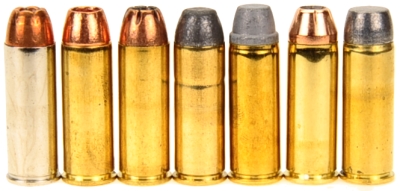
| Cartridge | Bullet Grains |
Mfg Rated FPS |
Recorded FPS 16″ BBL |
Energy Ft. Lbs |
50 Yard 3 shot Group” |
| Winchester PDX Defender |
225 | 850 | 1074 | 576 | 1.4 |
| Corbon DPX +P | 225 | 1200 | 1520 | 1155 | 1.9 |
| Remington HTP | 230 | 850 | 1062 | 576 | 1.6 |
| MagTech CAS | 250 | 761 | 951 | 502 | 2.2 |
| Buffalo Bore +P |
255 | 1000 | 1224 | 849 | 1.6 |
| Buffalo Bore Heavy Colt +P | 260 | 1450 | 1894 | 2072 | 1.3 |
| Grizzly Big Bore +P |
265 | 1400 | 1543 | 1401 | 1.8 |
Nice table, Joe, what’s your point?
It becomes obvious that even the short 16″ carbine can generate significantly greater power than a 5″ or 6″ barrel revolver and +P loads turn the little Winchester into a different type of rifle. In fact, the Buffalo Bore load out performs the 170 grain 30-30 WCF cartridge in a similar firearm. Yes, the bullets do have a ballistic coefficient of a mime in windstorm, but the 45 Colt doesn’t lose much at typical woodland hunting distances. As an example, with a +3″ ordinate, the Buffalo Bore load is point blank at 159 yards. At 200 yards, drop is approximate 7″ which is not a difficult hold over and 900 ft lbs of impact energy is more than sufficient to drop a deer.
Adding four inches to barrel length, comparisons with a 20″ barrel version of the Model 1892, doesn’t add to the cartridge significantly. Examples – The Corbon picked up 57 fps or 4%, Remington ammo picked up 16 fps, or 1.5%, Buffalo Bore Heavy Colt +P picked up 59 fps or 3%, and Grizzly picked up 46 fps or 3%. There is enough power in either barrel length for hunting deer, black bear, hogs, etc.
I don’t mind open metallic sights, although my eyes may have another opinion. Shooting was done from a sled, eyeglasses firmly in place, better eyes would get better groups. For me, the rifle handled so well I would not have a problem with factory sights out to 100 yards. There are aftermarket tang and receiver mount peep sight options for folks who prefer them. The Trapper form is a good geometry. It feels solid in any reasonable shooting position and the heft of the full hex barrel is steadying. Recoil with any of the loads was not noteable.
I’ve run out of words and used some way too often…
Come on, whatever I have to say regarding this rifle becomes superfluous following any picture. The Winchester Model 1892 Deluxe Trapper Takedown Case Hardened model is a beautiful rifle, produced by a high grade manufacturer and supported by over one hundred years of history. The Trapper length is lightweight, accurate and hard hitting. The price is a little steep for an old guy living in rural Maine, but it is a special rifle and there are other Winchester Model 1892s offered without the embellishments of materials and finish at significantly lower prices. I’m glad Winchester has continued with these historical models and hope there are many more ahead.

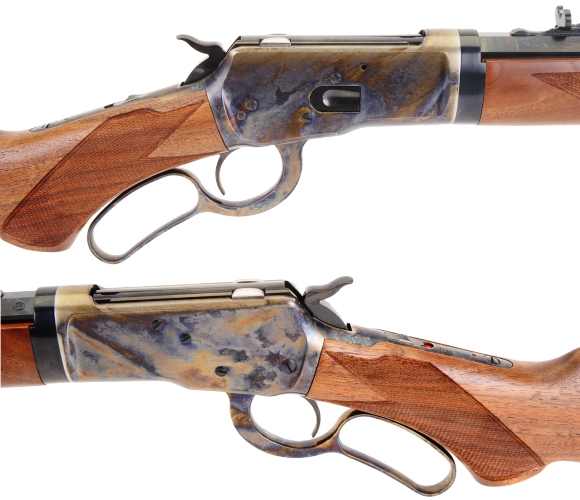
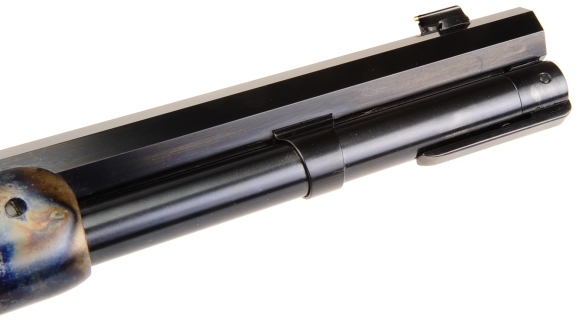
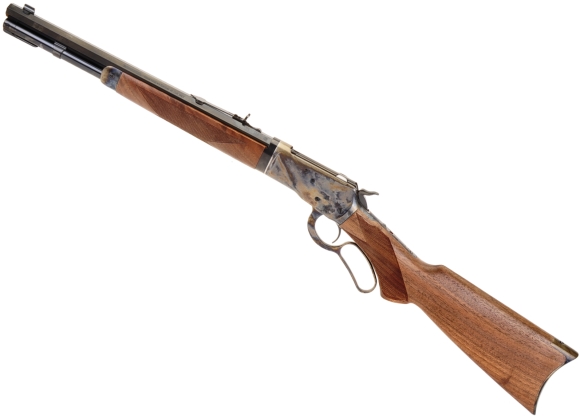
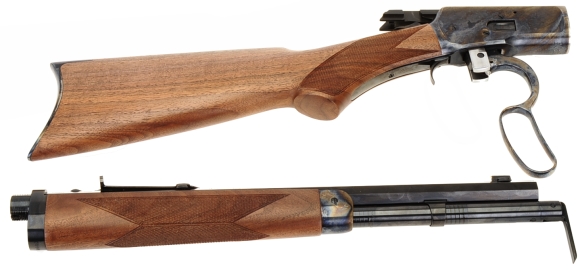
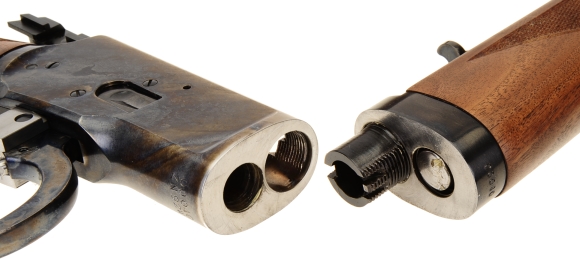

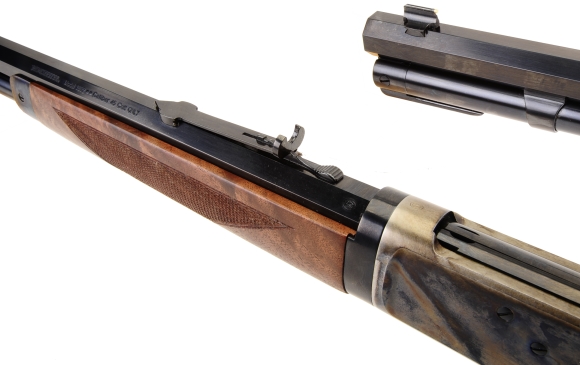
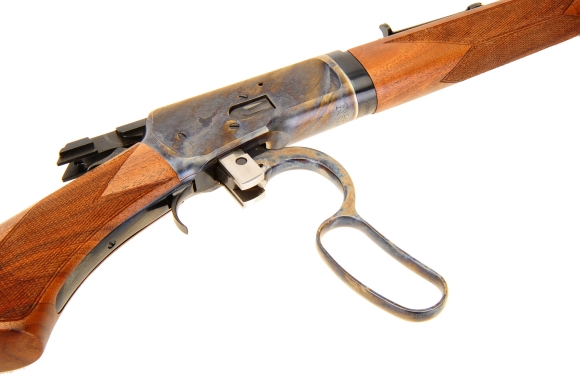
Email Notification